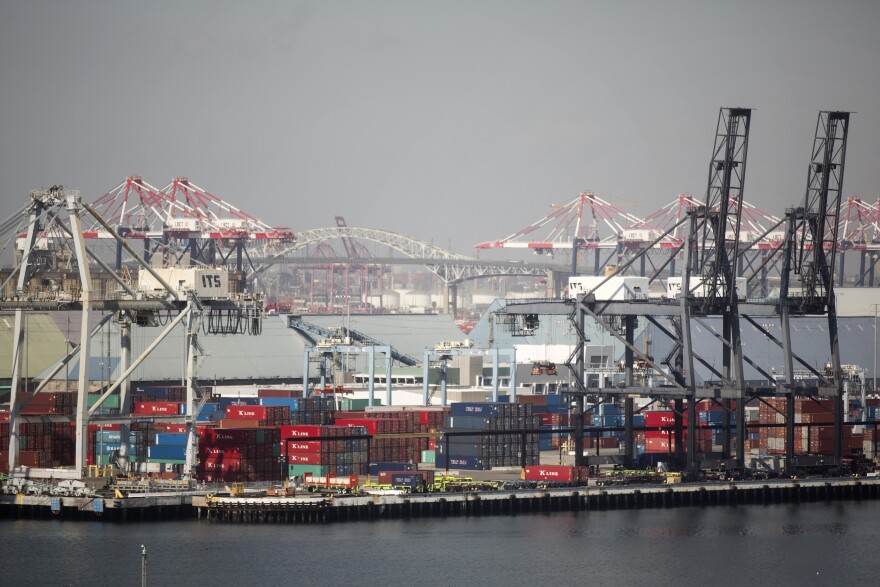With our free press under threat and federal funding for public media gone, your support matters more than ever. Help keep the LAist newsroom strong, become a monthly member or increase your support today.
Long Beach court victory could bring rail project screeching to a halt

The BNSF Railway Company has two months to decide whether to continue a legal fight fight to build a new rail yard near West Long Beach homes and schools or to abandon the project now that a judge has decided in favor of the rail yard's opponents.
The Southern California International Gateway (SCIG) would be on an industrial site four miles from the Port of Los Angeles, on 185 acres of land. The rail yard is called a "near-dock intermodal facility" — essentially, it's a place close to the ports of Long Beach and Los Angeles where trucks haul cargo containers to be loaded onto trains.
BNSF said its proposed new rail yard, which has been in the works since 2005, would reduce traffic and pollution for millions of Southern California residents because it's much closer to the ports. Each year, 1.3 million trucks leave the ports to drive 24 miles up the 710 Freeway to load cargo containers onto trains at the Hobart Railyard in the city of Commerce.
But Long Beach officials, environmentalists and West Long Beach residents who would live close to the proposed rail yard disagreed. In 2013, Long Beach city, the Long Beach Unified School District, the South Coast Air Quality Management District, the National Resources Defense Council and others sued the city of Los Angeles over its approval of the BNSF rail yard and its environmental study.
The environmental impact report noted that the burden of pollution and traffic from the project "would fall disproportionately on minority and low-income populations because the census block groups are adjacent to the point of impact."
Long Beach and the other plaintiffs objected that the added trucks and trains would increase the amount of ultrafine particles of pollution in the air around their homes and schools, making the West Long Beach area more polluted and unhealthy. Some 7,200 daily truck trips would pass by the entrance to veterans' transitional housing known as Villages at Cabrillo.
Long Beach isn't opposed to the rail yard being built in that location, said Assistant City Attorney Mike Mais. But the city wanted significant measures taken to reduce air, noise and light pollution that the railroad was unwilling to guarantee.
"The project is so big and it encompasses so many facets with trains and trucks, and the 24/7/365 operation that they needed to do more to mitigate so that the neighborhood that is east of them, which is our West Long Beach, would not be as impacted," Mais said.
Long Beach wanted the railroad to commit to using locomotives that meet the EPA's tough new Tier 4 standards for lowering the amounts of particulate matter that come from diesel engines, Mais said. The city also asked for a large berm to be built on the rail yard's perimeter shielding its 24-hour operations from homes. The city also wanted to protect residents from light pollution and take steps to reduce the noise of shipping containers being loaded onto train chassis.
On Tuesday, the rail yard opponents won a final judgement in court. The ruling said BNSF's environmental impact report didn't include enough measures to reduce potential harms to residents.
The proposed rail yard was slated for heavy industrial land between Sepulveda Boulevard and Pacific Coast Highway, with the Dominguez Channel and Tesoro oil refinery to the west and the Terminal Island Freeway to the east.
Attorney David Pettit of the Natural Resources Defense Council said that amid many politicians' attacks on California's body of environmental regulations, known as CEQA (California Environmental Quality Act), this was one case where it worked to the community's benefit.
"You've got what the judge has realized is a bad project that wasn't analyzed properly and there are mitigation measures that should have been at least analyzed and weren't," Pettit said. "So this is exactly how it's supposed to work."
Forcing the rail yard to use only low-emission train locomotives and zero-emission trucks would cost about $3 billion — or about six times the entire rail yard's estimated $500 million cost, said BNSF spokeswoman Lena Kent.
The company had already agreed to install a sound wall, she said.
"We do not see a path forward in terms of negotiating a settlement with the parties," Kent said in an email statement. "If we elect to appeal it does not mean that we will move forward with the project. We are evaluating how best to serve our customers without SCIG."
She said the region will have to come up with better alternatives to handle cargo projected to come into the ports of Los Angeles and Long Beach if near-dock rail yards like what BNSF had proposed are unacceptable.
"I do not believe that anyone won with this recent decision, as the community and broader region won't benefit from the traffic reductions, air quality improvements and good jobs SCIG would have brought," she said.








